Healthcare Assignment: Physical Health Status Analysis, AT2
VerifiedAdded on 2023/01/17
|20
|4305
|29
Homework Assignment
AI Summary
This assignment delves into various aspects of physical health, beginning with an analysis of hypothermia, including its causes and the body's homeostatic responses. It then explores cellular adaptation, outlining different types such as hypertrophy and hyperplasia. The assignment further investigates atheroma formation, detailing its steps and related factors like lipoproteins and macrophages. It also covers the structure and function of skin, changes in eyesight due to aging, and conditions like Type 2 diabetes, hyperlipidemia, and respiratory processes. The document examines the role of different medications in treating related conditions and provides an overview of normal external respiratory and respiratory gas transport. The assignment also includes a multidisciplinary team, and the EN's knowledge regarding pathology results.

Running head: HEALTHCARE 1
Confirm Physical Health Status
Student Name
Institution
Confirm Physical Health Status
Student Name
Institution
Paraphrase This Document
Need a fresh take? Get an instant paraphrase of this document with our AI Paraphraser
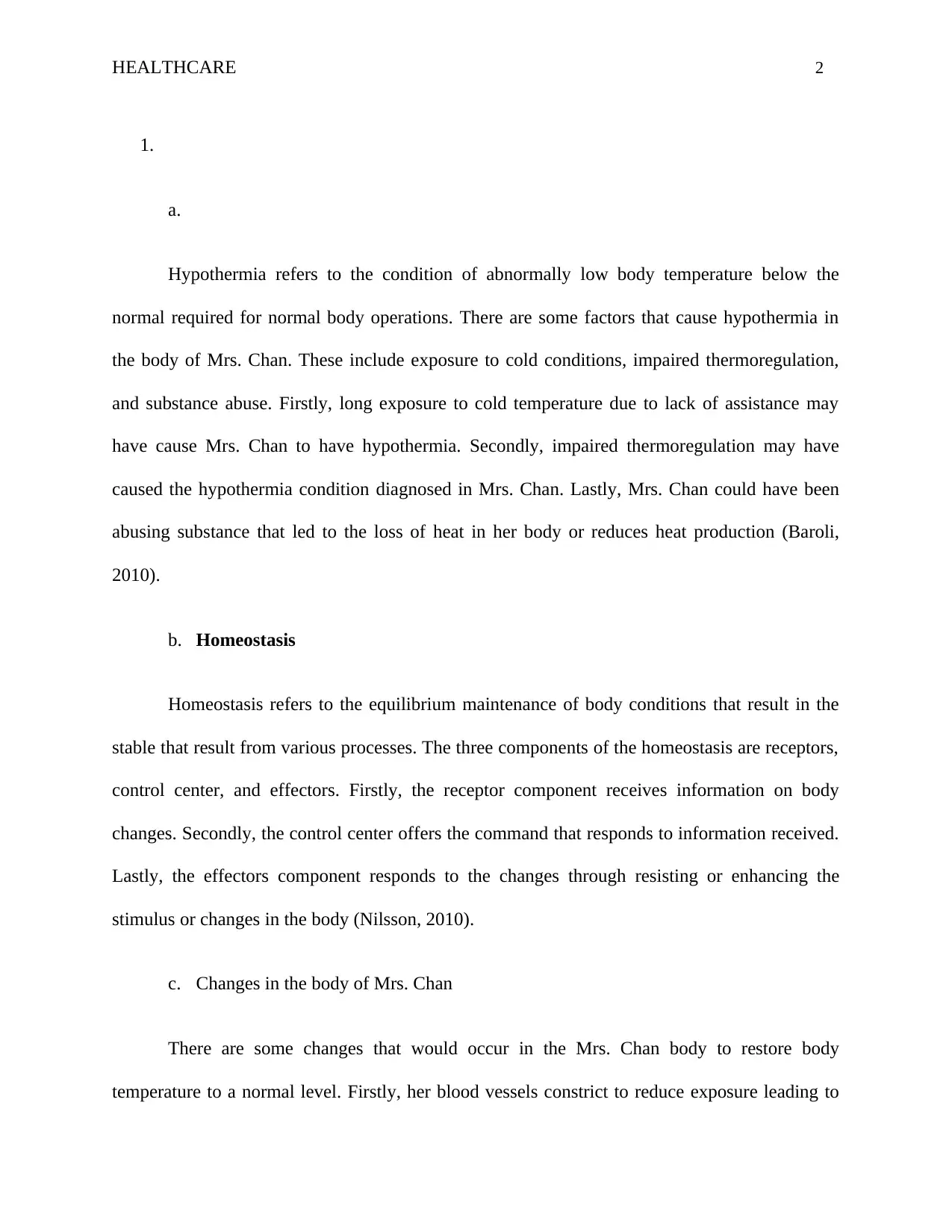
HEALTHCARE 2
1.
a.
Hypothermia refers to the condition of abnormally low body temperature below the
normal required for normal body operations. There are some factors that cause hypothermia in
the body of Mrs. Chan. These include exposure to cold conditions, impaired thermoregulation,
and substance abuse. Firstly, long exposure to cold temperature due to lack of assistance may
have cause Mrs. Chan to have hypothermia. Secondly, impaired thermoregulation may have
caused the hypothermia condition diagnosed in Mrs. Chan. Lastly, Mrs. Chan could have been
abusing substance that led to the loss of heat in her body or reduces heat production (Baroli,
2010).
b. Homeostasis
Homeostasis refers to the equilibrium maintenance of body conditions that result in the
stable that result from various processes. The three components of the homeostasis are receptors,
control center, and effectors. Firstly, the receptor component receives information on body
changes. Secondly, the control center offers the command that responds to information received.
Lastly, the effectors component responds to the changes through resisting or enhancing the
stimulus or changes in the body (Nilsson, 2010).
c. Changes in the body of Mrs. Chan
There are some changes that would occur in the Mrs. Chan body to restore body
temperature to a normal level. Firstly, her blood vessels constrict to reduce exposure leading to
1.
a.
Hypothermia refers to the condition of abnormally low body temperature below the
normal required for normal body operations. There are some factors that cause hypothermia in
the body of Mrs. Chan. These include exposure to cold conditions, impaired thermoregulation,
and substance abuse. Firstly, long exposure to cold temperature due to lack of assistance may
have cause Mrs. Chan to have hypothermia. Secondly, impaired thermoregulation may have
caused the hypothermia condition diagnosed in Mrs. Chan. Lastly, Mrs. Chan could have been
abusing substance that led to the loss of heat in her body or reduces heat production (Baroli,
2010).
b. Homeostasis
Homeostasis refers to the equilibrium maintenance of body conditions that result in the
stable that result from various processes. The three components of the homeostasis are receptors,
control center, and effectors. Firstly, the receptor component receives information on body
changes. Secondly, the control center offers the command that responds to information received.
Lastly, the effectors component responds to the changes through resisting or enhancing the
stimulus or changes in the body (Nilsson, 2010).
c. Changes in the body of Mrs. Chan
There are some changes that would occur in the Mrs. Chan body to restore body
temperature to a normal level. Firstly, her blood vessels constrict to reduce exposure leading to
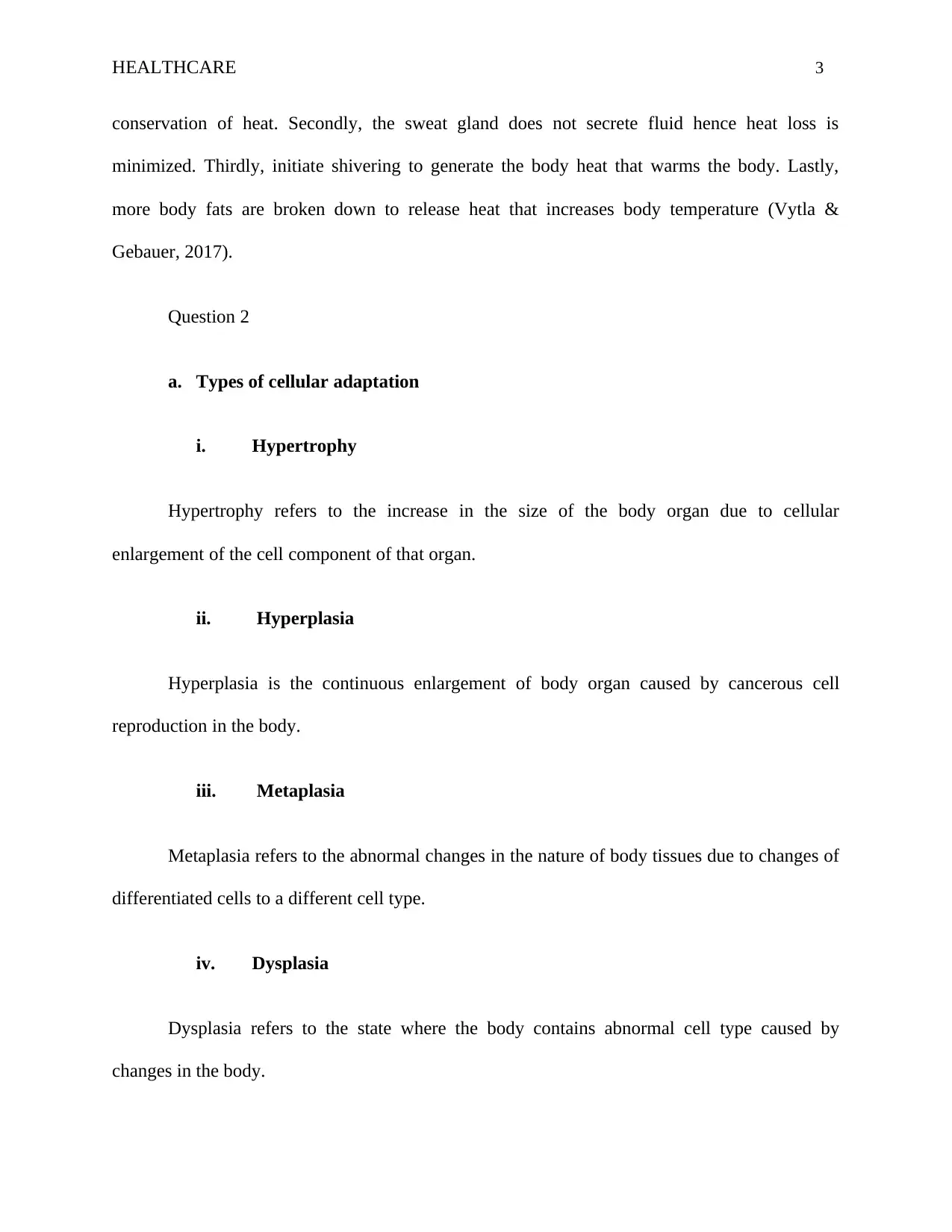
HEALTHCARE 3
conservation of heat. Secondly, the sweat gland does not secrete fluid hence heat loss is
minimized. Thirdly, initiate shivering to generate the body heat that warms the body. Lastly,
more body fats are broken down to release heat that increases body temperature (Vytla &
Gebauer, 2017).
Question 2
a. Types of cellular adaptation
i. Hypertrophy
Hypertrophy refers to the increase in the size of the body organ due to cellular
enlargement of the cell component of that organ.
ii. Hyperplasia
Hyperplasia is the continuous enlargement of body organ caused by cancerous cell
reproduction in the body.
iii. Metaplasia
Metaplasia refers to the abnormal changes in the nature of body tissues due to changes of
differentiated cells to a different cell type.
iv. Dysplasia
Dysplasia refers to the state where the body contains abnormal cell type caused by
changes in the body.
conservation of heat. Secondly, the sweat gland does not secrete fluid hence heat loss is
minimized. Thirdly, initiate shivering to generate the body heat that warms the body. Lastly,
more body fats are broken down to release heat that increases body temperature (Vytla &
Gebauer, 2017).
Question 2
a. Types of cellular adaptation
i. Hypertrophy
Hypertrophy refers to the increase in the size of the body organ due to cellular
enlargement of the cell component of that organ.
ii. Hyperplasia
Hyperplasia is the continuous enlargement of body organ caused by cancerous cell
reproduction in the body.
iii. Metaplasia
Metaplasia refers to the abnormal changes in the nature of body tissues due to changes of
differentiated cells to a different cell type.
iv. Dysplasia
Dysplasia refers to the state where the body contains abnormal cell type caused by
changes in the body.
⊘ This is a preview!⊘
Do you want full access?
Subscribe today to unlock all pages.

Trusted by 1+ million students worldwide
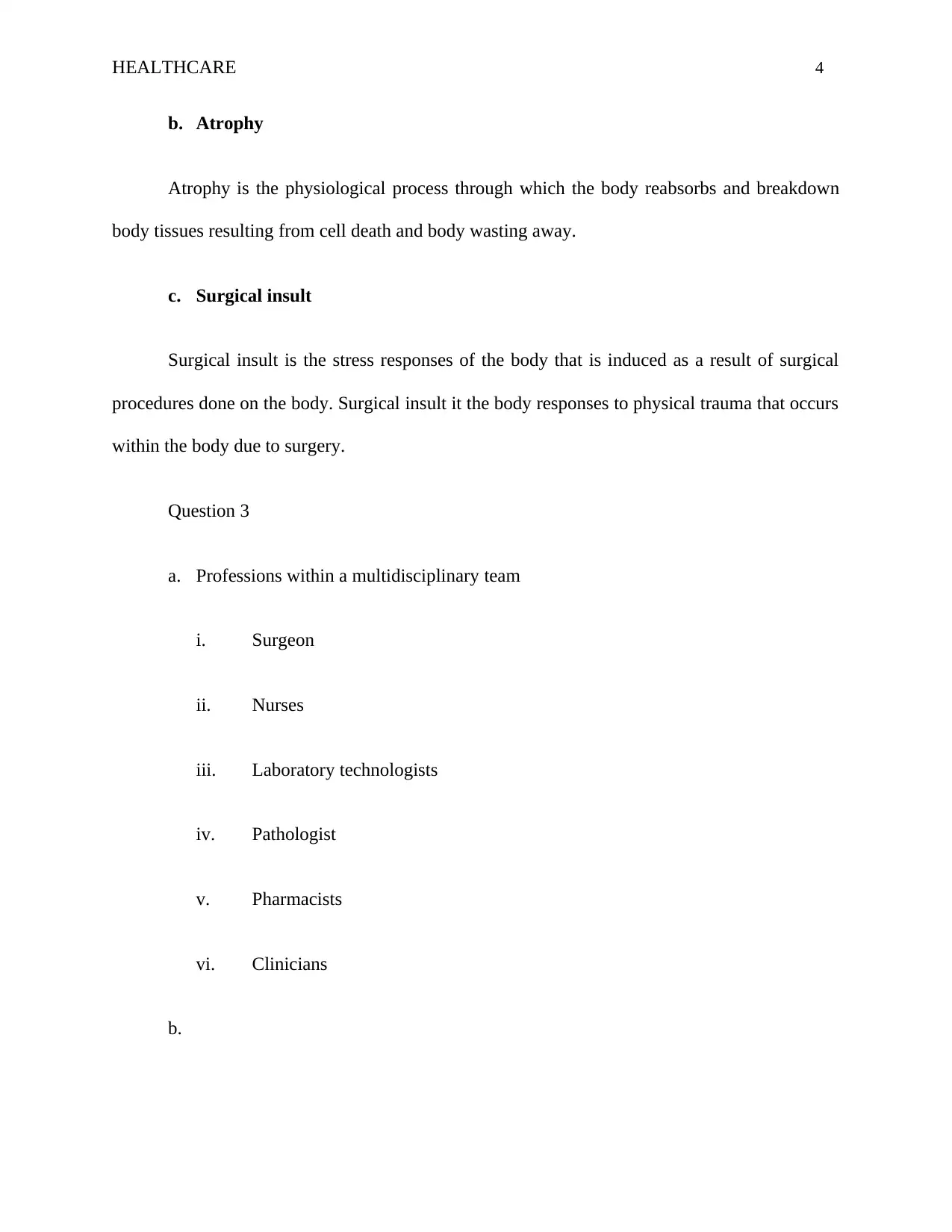
HEALTHCARE 4
b. Atrophy
Atrophy is the physiological process through which the body reabsorbs and breakdown
body tissues resulting from cell death and body wasting away.
c. Surgical insult
Surgical insult is the stress responses of the body that is induced as a result of surgical
procedures done on the body. Surgical insult it the body responses to physical trauma that occurs
within the body due to surgery.
Question 3
a. Professions within a multidisciplinary team
i. Surgeon
ii. Nurses
iii. Laboratory technologists
iv. Pathologist
v. Pharmacists
vi. Clinicians
b.
b. Atrophy
Atrophy is the physiological process through which the body reabsorbs and breakdown
body tissues resulting from cell death and body wasting away.
c. Surgical insult
Surgical insult is the stress responses of the body that is induced as a result of surgical
procedures done on the body. Surgical insult it the body responses to physical trauma that occurs
within the body due to surgery.
Question 3
a. Professions within a multidisciplinary team
i. Surgeon
ii. Nurses
iii. Laboratory technologists
iv. Pathologist
v. Pharmacists
vi. Clinicians
b.
Paraphrase This Document
Need a fresh take? Get an instant paraphrase of this document with our AI Paraphraser
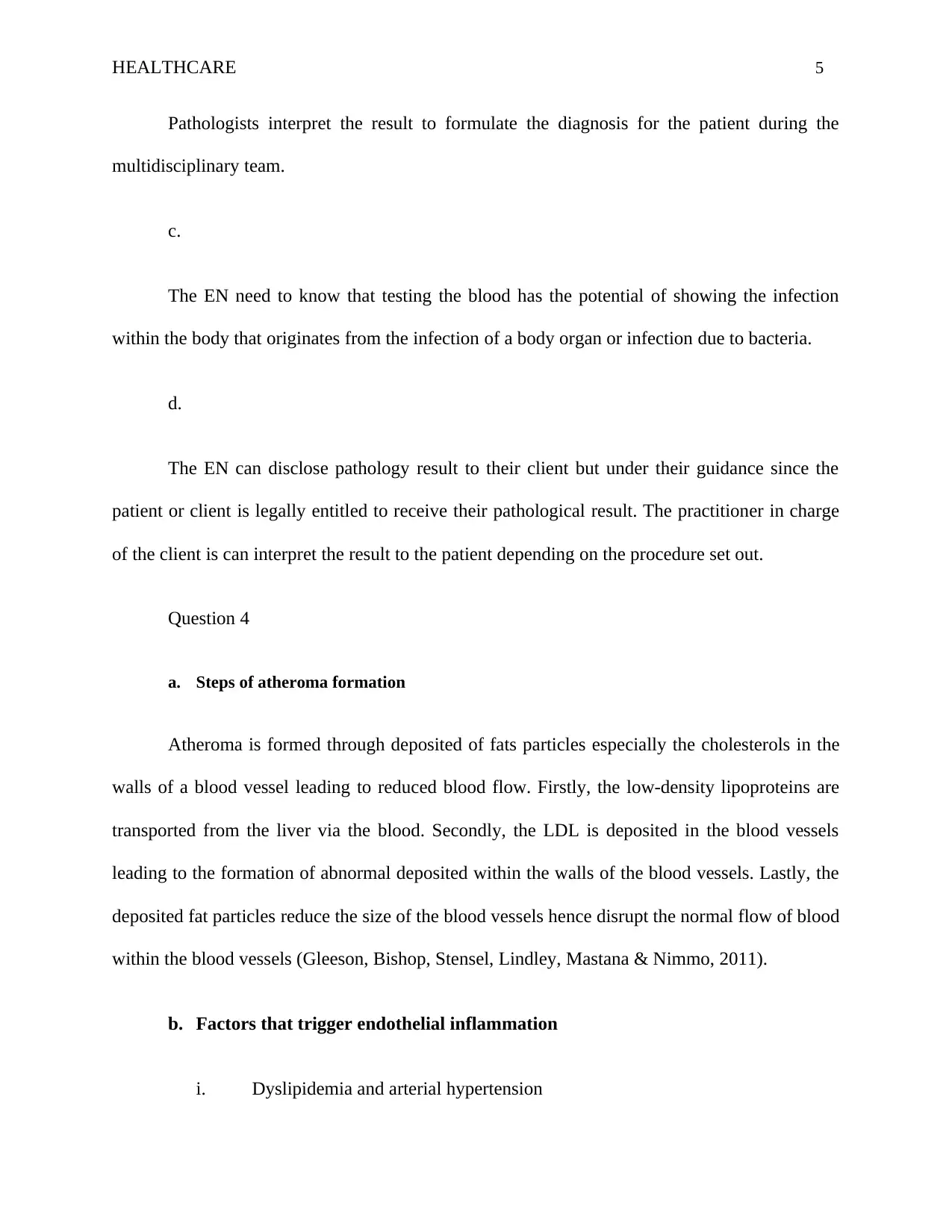
HEALTHCARE 5
Pathologists interpret the result to formulate the diagnosis for the patient during the
multidisciplinary team.
c.
The EN need to know that testing the blood has the potential of showing the infection
within the body that originates from the infection of a body organ or infection due to bacteria.
d.
The EN can disclose pathology result to their client but under their guidance since the
patient or client is legally entitled to receive their pathological result. The practitioner in charge
of the client is can interpret the result to the patient depending on the procedure set out.
Question 4
a. Steps of atheroma formation
Atheroma is formed through deposited of fats particles especially the cholesterols in the
walls of a blood vessel leading to reduced blood flow. Firstly, the low-density lipoproteins are
transported from the liver via the blood. Secondly, the LDL is deposited in the blood vessels
leading to the formation of abnormal deposited within the walls of the blood vessels. Lastly, the
deposited fat particles reduce the size of the blood vessels hence disrupt the normal flow of blood
within the blood vessels (Gleeson, Bishop, Stensel, Lindley, Mastana & Nimmo, 2011).
b. Factors that trigger endothelial inflammation
i. Dyslipidemia and arterial hypertension
Pathologists interpret the result to formulate the diagnosis for the patient during the
multidisciplinary team.
c.
The EN need to know that testing the blood has the potential of showing the infection
within the body that originates from the infection of a body organ or infection due to bacteria.
d.
The EN can disclose pathology result to their client but under their guidance since the
patient or client is legally entitled to receive their pathological result. The practitioner in charge
of the client is can interpret the result to the patient depending on the procedure set out.
Question 4
a. Steps of atheroma formation
Atheroma is formed through deposited of fats particles especially the cholesterols in the
walls of a blood vessel leading to reduced blood flow. Firstly, the low-density lipoproteins are
transported from the liver via the blood. Secondly, the LDL is deposited in the blood vessels
leading to the formation of abnormal deposited within the walls of the blood vessels. Lastly, the
deposited fat particles reduce the size of the blood vessels hence disrupt the normal flow of blood
within the blood vessels (Gleeson, Bishop, Stensel, Lindley, Mastana & Nimmo, 2011).
b. Factors that trigger endothelial inflammation
i. Dyslipidemia and arterial hypertension
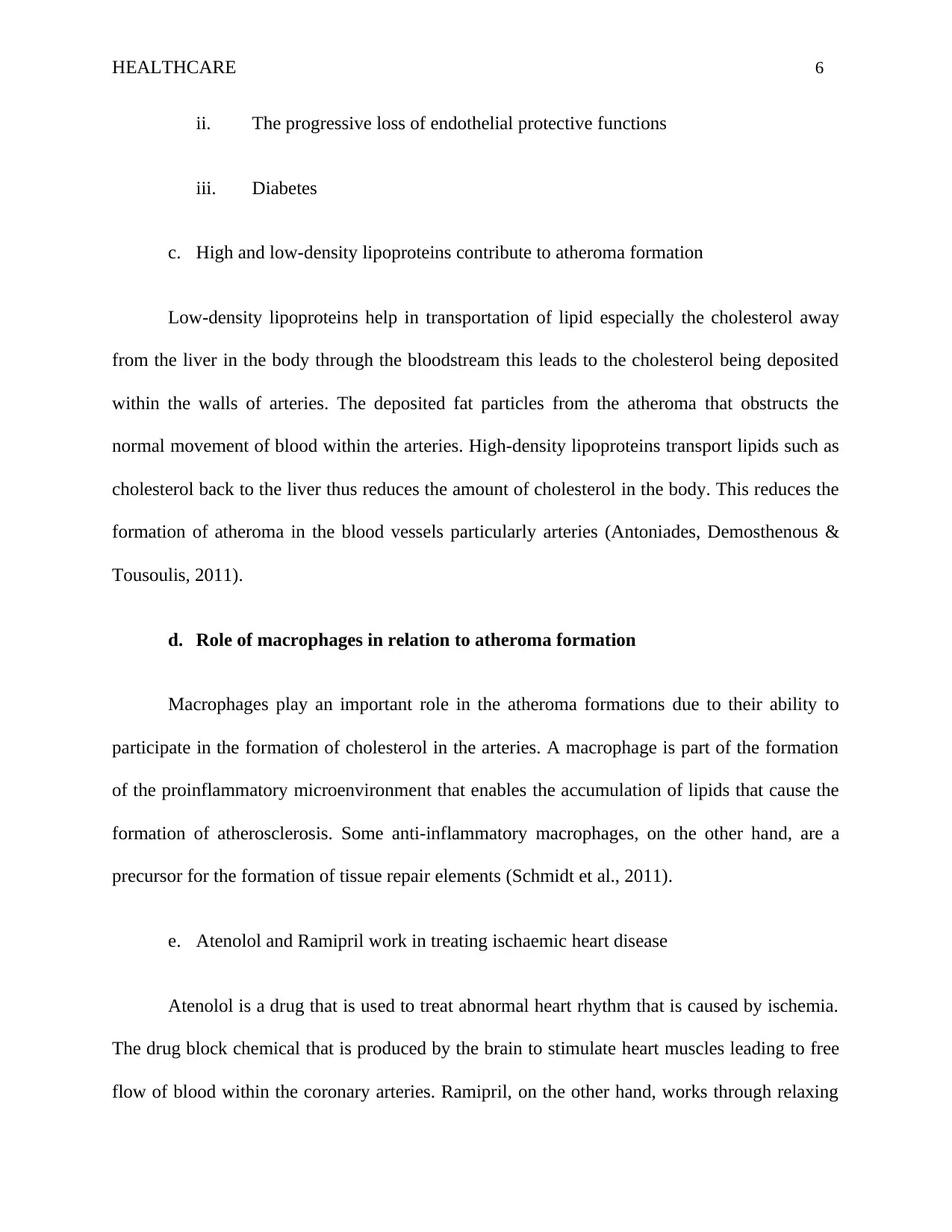
HEALTHCARE 6
ii. The progressive loss of endothelial protective functions
iii. Diabetes
c. High and low-density lipoproteins contribute to atheroma formation
Low-density lipoproteins help in transportation of lipid especially the cholesterol away
from the liver in the body through the bloodstream this leads to the cholesterol being deposited
within the walls of arteries. The deposited fat particles from the atheroma that obstructs the
normal movement of blood within the arteries. High-density lipoproteins transport lipids such as
cholesterol back to the liver thus reduces the amount of cholesterol in the body. This reduces the
formation of atheroma in the blood vessels particularly arteries (Antoniades, Demosthenous &
Tousoulis, 2011).
d. Role of macrophages in relation to atheroma formation
Macrophages play an important role in the atheroma formations due to their ability to
participate in the formation of cholesterol in the arteries. A macrophage is part of the formation
of the proinflammatory microenvironment that enables the accumulation of lipids that cause the
formation of atherosclerosis. Some anti-inflammatory macrophages, on the other hand, are a
precursor for the formation of tissue repair elements (Schmidt et al., 2011).
e. Atenolol and Ramipril work in treating ischaemic heart disease
Atenolol is a drug that is used to treat abnormal heart rhythm that is caused by ischemia.
The drug block chemical that is produced by the brain to stimulate heart muscles leading to free
flow of blood within the coronary arteries. Ramipril, on the other hand, works through relaxing
ii. The progressive loss of endothelial protective functions
iii. Diabetes
c. High and low-density lipoproteins contribute to atheroma formation
Low-density lipoproteins help in transportation of lipid especially the cholesterol away
from the liver in the body through the bloodstream this leads to the cholesterol being deposited
within the walls of arteries. The deposited fat particles from the atheroma that obstructs the
normal movement of blood within the arteries. High-density lipoproteins transport lipids such as
cholesterol back to the liver thus reduces the amount of cholesterol in the body. This reduces the
formation of atheroma in the blood vessels particularly arteries (Antoniades, Demosthenous &
Tousoulis, 2011).
d. Role of macrophages in relation to atheroma formation
Macrophages play an important role in the atheroma formations due to their ability to
participate in the formation of cholesterol in the arteries. A macrophage is part of the formation
of the proinflammatory microenvironment that enables the accumulation of lipids that cause the
formation of atherosclerosis. Some anti-inflammatory macrophages, on the other hand, are a
precursor for the formation of tissue repair elements (Schmidt et al., 2011).
e. Atenolol and Ramipril work in treating ischaemic heart disease
Atenolol is a drug that is used to treat abnormal heart rhythm that is caused by ischemia.
The drug block chemical that is produced by the brain to stimulate heart muscles leading to free
flow of blood within the coronary arteries. Ramipril, on the other hand, works through relaxing
⊘ This is a preview!⊘
Do you want full access?
Subscribe today to unlock all pages.

Trusted by 1+ million students worldwide
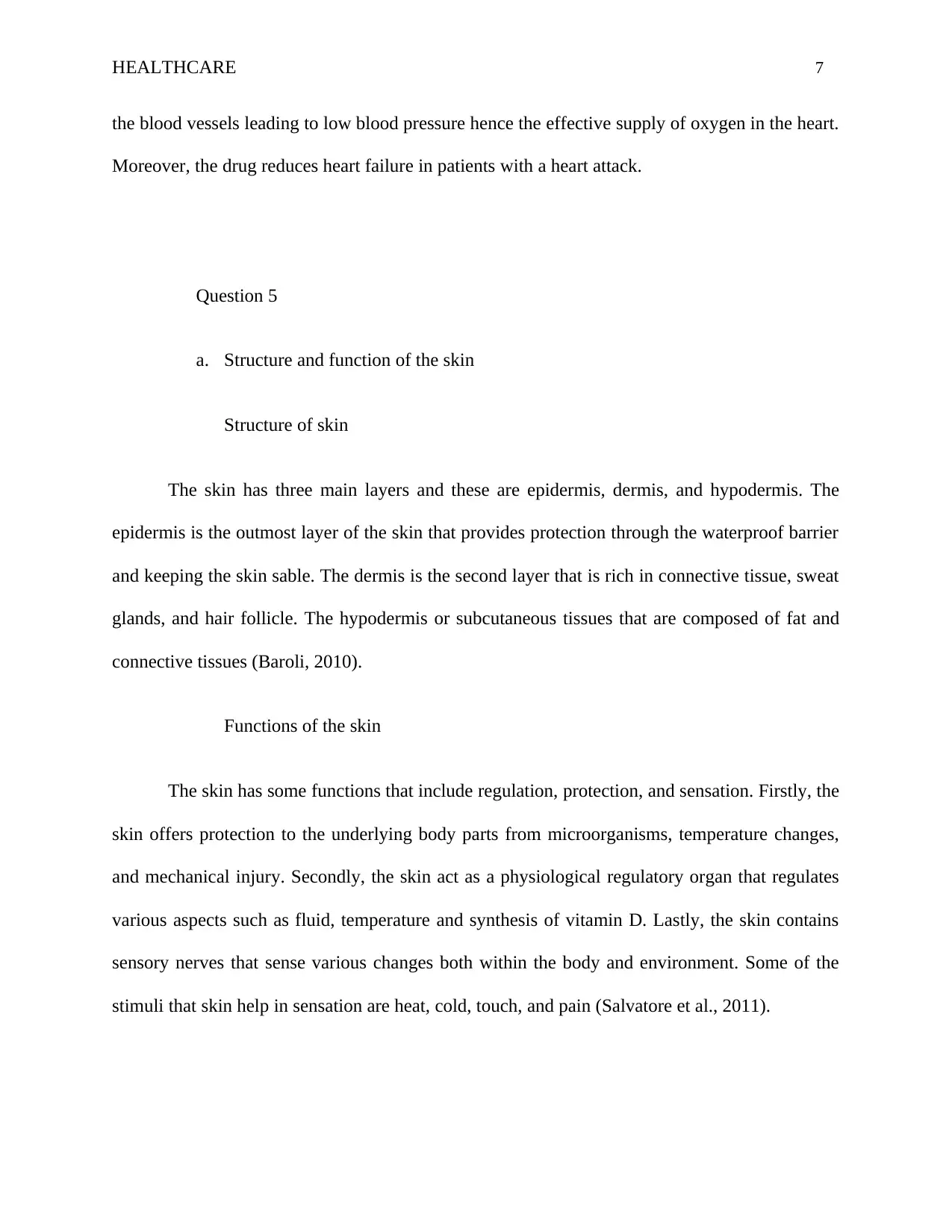
HEALTHCARE 7
the blood vessels leading to low blood pressure hence the effective supply of oxygen in the heart.
Moreover, the drug reduces heart failure in patients with a heart attack.
Question 5
a. Structure and function of the skin
Structure of skin
The skin has three main layers and these are epidermis, dermis, and hypodermis. The
epidermis is the outmost layer of the skin that provides protection through the waterproof barrier
and keeping the skin sable. The dermis is the second layer that is rich in connective tissue, sweat
glands, and hair follicle. The hypodermis or subcutaneous tissues that are composed of fat and
connective tissues (Baroli, 2010).
Functions of the skin
The skin has some functions that include regulation, protection, and sensation. Firstly, the
skin offers protection to the underlying body parts from microorganisms, temperature changes,
and mechanical injury. Secondly, the skin act as a physiological regulatory organ that regulates
various aspects such as fluid, temperature and synthesis of vitamin D. Lastly, the skin contains
sensory nerves that sense various changes both within the body and environment. Some of the
stimuli that skin help in sensation are heat, cold, touch, and pain (Salvatore et al., 2011).
the blood vessels leading to low blood pressure hence the effective supply of oxygen in the heart.
Moreover, the drug reduces heart failure in patients with a heart attack.
Question 5
a. Structure and function of the skin
Structure of skin
The skin has three main layers and these are epidermis, dermis, and hypodermis. The
epidermis is the outmost layer of the skin that provides protection through the waterproof barrier
and keeping the skin sable. The dermis is the second layer that is rich in connective tissue, sweat
glands, and hair follicle. The hypodermis or subcutaneous tissues that are composed of fat and
connective tissues (Baroli, 2010).
Functions of the skin
The skin has some functions that include regulation, protection, and sensation. Firstly, the
skin offers protection to the underlying body parts from microorganisms, temperature changes,
and mechanical injury. Secondly, the skin act as a physiological regulatory organ that regulates
various aspects such as fluid, temperature and synthesis of vitamin D. Lastly, the skin contains
sensory nerves that sense various changes both within the body and environment. Some of the
stimuli that skin help in sensation are heat, cold, touch, and pain (Salvatore et al., 2011).
Paraphrase This Document
Need a fresh take? Get an instant paraphrase of this document with our AI Paraphraser
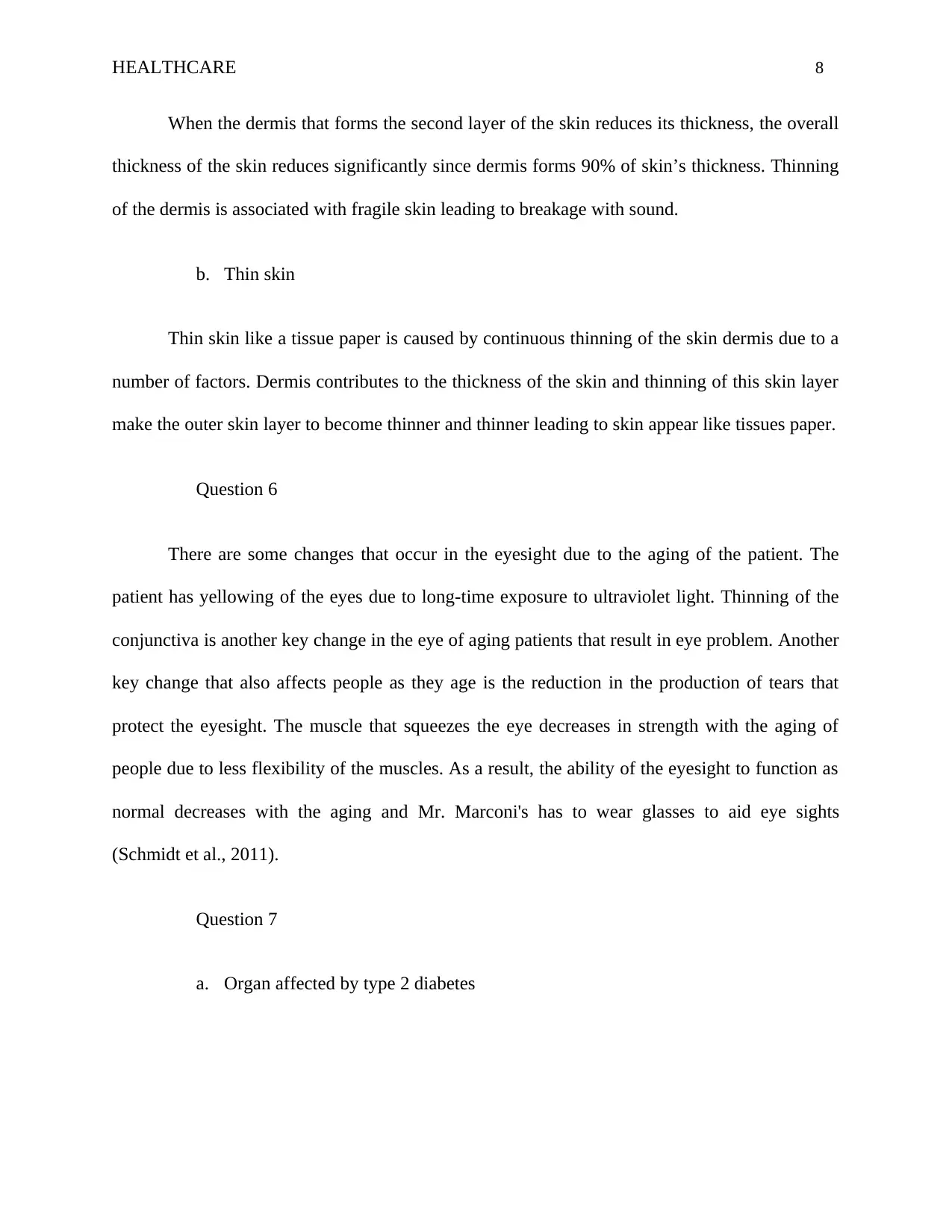
HEALTHCARE 8
When the dermis that forms the second layer of the skin reduces its thickness, the overall
thickness of the skin reduces significantly since dermis forms 90% of skin’s thickness. Thinning
of the dermis is associated with fragile skin leading to breakage with sound.
b. Thin skin
Thin skin like a tissue paper is caused by continuous thinning of the skin dermis due to a
number of factors. Dermis contributes to the thickness of the skin and thinning of this skin layer
make the outer skin layer to become thinner and thinner leading to skin appear like tissues paper.
Question 6
There are some changes that occur in the eyesight due to the aging of the patient. The
patient has yellowing of the eyes due to long-time exposure to ultraviolet light. Thinning of the
conjunctiva is another key change in the eye of aging patients that result in eye problem. Another
key change that also affects people as they age is the reduction in the production of tears that
protect the eyesight. The muscle that squeezes the eye decreases in strength with the aging of
people due to less flexibility of the muscles. As a result, the ability of the eyesight to function as
normal decreases with the aging and Mr. Marconi's has to wear glasses to aid eye sights
(Schmidt et al., 2011).
Question 7
a. Organ affected by type 2 diabetes
When the dermis that forms the second layer of the skin reduces its thickness, the overall
thickness of the skin reduces significantly since dermis forms 90% of skin’s thickness. Thinning
of the dermis is associated with fragile skin leading to breakage with sound.
b. Thin skin
Thin skin like a tissue paper is caused by continuous thinning of the skin dermis due to a
number of factors. Dermis contributes to the thickness of the skin and thinning of this skin layer
make the outer skin layer to become thinner and thinner leading to skin appear like tissues paper.
Question 6
There are some changes that occur in the eyesight due to the aging of the patient. The
patient has yellowing of the eyes due to long-time exposure to ultraviolet light. Thinning of the
conjunctiva is another key change in the eye of aging patients that result in eye problem. Another
key change that also affects people as they age is the reduction in the production of tears that
protect the eyesight. The muscle that squeezes the eye decreases in strength with the aging of
people due to less flexibility of the muscles. As a result, the ability of the eyesight to function as
normal decreases with the aging and Mr. Marconi's has to wear glasses to aid eye sights
(Schmidt et al., 2011).
Question 7
a. Organ affected by type 2 diabetes
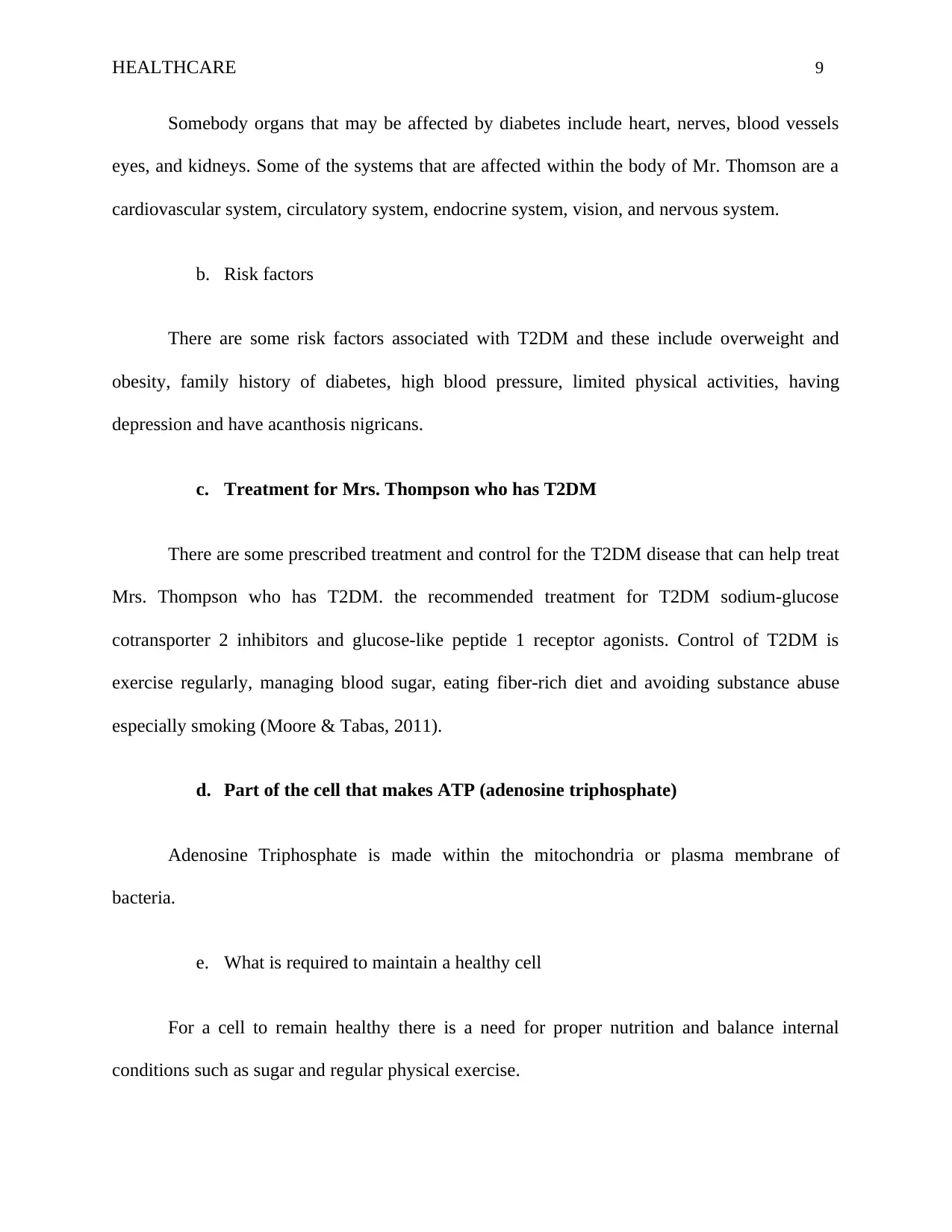
HEALTHCARE 9
Somebody organs that may be affected by diabetes include heart, nerves, blood vessels
eyes, and kidneys. Some of the systems that are affected within the body of Mr. Thomson are a
cardiovascular system, circulatory system, endocrine system, vision, and nervous system.
b. Risk factors
There are some risk factors associated with T2DM and these include overweight and
obesity, family history of diabetes, high blood pressure, limited physical activities, having
depression and have acanthosis nigricans.
c. Treatment for Mrs. Thompson who has T2DM
There are some prescribed treatment and control for the T2DM disease that can help treat
Mrs. Thompson who has T2DM. the recommended treatment for T2DM sodium-glucose
cotransporter 2 inhibitors and glucose-like peptide 1 receptor agonists. Control of T2DM is
exercise regularly, managing blood sugar, eating fiber-rich diet and avoiding substance abuse
especially smoking (Moore & Tabas, 2011).
d. Part of the cell that makes ATP (adenosine triphosphate)
Adenosine Triphosphate is made within the mitochondria or plasma membrane of
bacteria.
e. What is required to maintain a healthy cell
For a cell to remain healthy there is a need for proper nutrition and balance internal
conditions such as sugar and regular physical exercise.
Somebody organs that may be affected by diabetes include heart, nerves, blood vessels
eyes, and kidneys. Some of the systems that are affected within the body of Mr. Thomson are a
cardiovascular system, circulatory system, endocrine system, vision, and nervous system.
b. Risk factors
There are some risk factors associated with T2DM and these include overweight and
obesity, family history of diabetes, high blood pressure, limited physical activities, having
depression and have acanthosis nigricans.
c. Treatment for Mrs. Thompson who has T2DM
There are some prescribed treatment and control for the T2DM disease that can help treat
Mrs. Thompson who has T2DM. the recommended treatment for T2DM sodium-glucose
cotransporter 2 inhibitors and glucose-like peptide 1 receptor agonists. Control of T2DM is
exercise regularly, managing blood sugar, eating fiber-rich diet and avoiding substance abuse
especially smoking (Moore & Tabas, 2011).
d. Part of the cell that makes ATP (adenosine triphosphate)
Adenosine Triphosphate is made within the mitochondria or plasma membrane of
bacteria.
e. What is required to maintain a healthy cell
For a cell to remain healthy there is a need for proper nutrition and balance internal
conditions such as sugar and regular physical exercise.
⊘ This is a preview!⊘
Do you want full access?
Subscribe today to unlock all pages.

Trusted by 1+ million students worldwide
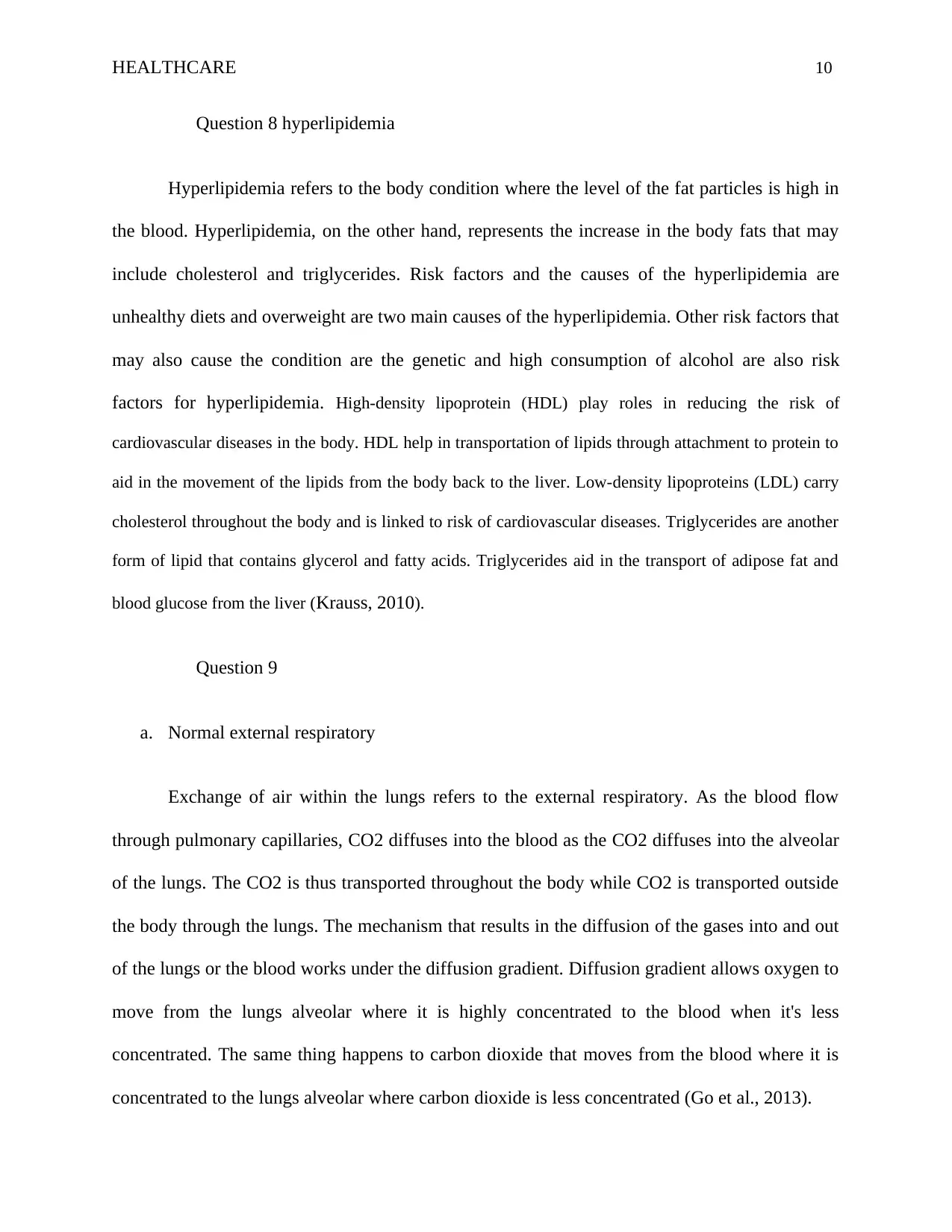
HEALTHCARE 10
Question 8 hyperlipidemia
Hyperlipidemia refers to the body condition where the level of the fat particles is high in
the blood. Hyperlipidemia, on the other hand, represents the increase in the body fats that may
include cholesterol and triglycerides. Risk factors and the causes of the hyperlipidemia are
unhealthy diets and overweight are two main causes of the hyperlipidemia. Other risk factors that
may also cause the condition are the genetic and high consumption of alcohol are also risk
factors for hyperlipidemia. High-density lipoprotein (HDL) play roles in reducing the risk of
cardiovascular diseases in the body. HDL help in transportation of lipids through attachment to protein to
aid in the movement of the lipids from the body back to the liver. Low-density lipoproteins (LDL) carry
cholesterol throughout the body and is linked to risk of cardiovascular diseases. Triglycerides are another
form of lipid that contains glycerol and fatty acids. Triglycerides aid in the transport of adipose fat and
blood glucose from the liver (Krauss, 2010).
Question 9
a. Normal external respiratory
Exchange of air within the lungs refers to the external respiratory. As the blood flow
through pulmonary capillaries, CO2 diffuses into the blood as the CO2 diffuses into the alveolar
of the lungs. The CO2 is thus transported throughout the body while CO2 is transported outside
the body through the lungs. The mechanism that results in the diffusion of the gases into and out
of the lungs or the blood works under the diffusion gradient. Diffusion gradient allows oxygen to
move from the lungs alveolar where it is highly concentrated to the blood when it's less
concentrated. The same thing happens to carbon dioxide that moves from the blood where it is
concentrated to the lungs alveolar where carbon dioxide is less concentrated (Go et al., 2013).
Question 8 hyperlipidemia
Hyperlipidemia refers to the body condition where the level of the fat particles is high in
the blood. Hyperlipidemia, on the other hand, represents the increase in the body fats that may
include cholesterol and triglycerides. Risk factors and the causes of the hyperlipidemia are
unhealthy diets and overweight are two main causes of the hyperlipidemia. Other risk factors that
may also cause the condition are the genetic and high consumption of alcohol are also risk
factors for hyperlipidemia. High-density lipoprotein (HDL) play roles in reducing the risk of
cardiovascular diseases in the body. HDL help in transportation of lipids through attachment to protein to
aid in the movement of the lipids from the body back to the liver. Low-density lipoproteins (LDL) carry
cholesterol throughout the body and is linked to risk of cardiovascular diseases. Triglycerides are another
form of lipid that contains glycerol and fatty acids. Triglycerides aid in the transport of adipose fat and
blood glucose from the liver (Krauss, 2010).
Question 9
a. Normal external respiratory
Exchange of air within the lungs refers to the external respiratory. As the blood flow
through pulmonary capillaries, CO2 diffuses into the blood as the CO2 diffuses into the alveolar
of the lungs. The CO2 is thus transported throughout the body while CO2 is transported outside
the body through the lungs. The mechanism that results in the diffusion of the gases into and out
of the lungs or the blood works under the diffusion gradient. Diffusion gradient allows oxygen to
move from the lungs alveolar where it is highly concentrated to the blood when it's less
concentrated. The same thing happens to carbon dioxide that moves from the blood where it is
concentrated to the lungs alveolar where carbon dioxide is less concentrated (Go et al., 2013).
Paraphrase This Document
Need a fresh take? Get an instant paraphrase of this document with our AI Paraphraser
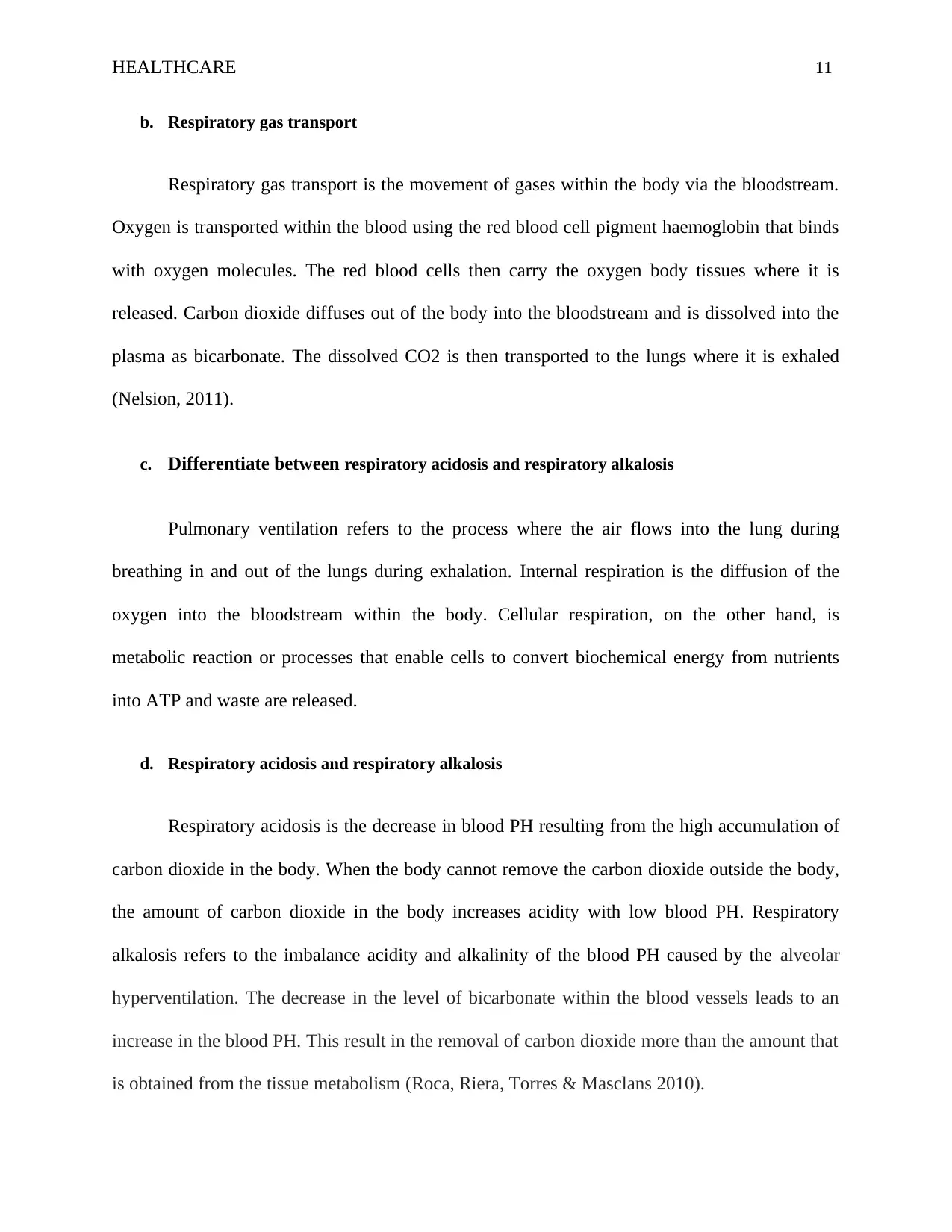
HEALTHCARE 11
b. Respiratory gas transport
Respiratory gas transport is the movement of gases within the body via the bloodstream.
Oxygen is transported within the blood using the red blood cell pigment haemoglobin that binds
with oxygen molecules. The red blood cells then carry the oxygen body tissues where it is
released. Carbon dioxide diffuses out of the body into the bloodstream and is dissolved into the
plasma as bicarbonate. The dissolved CO2 is then transported to the lungs where it is exhaled
(Nelsion, 2011).
c. Differentiate between respiratory acidosis and respiratory alkalosis
Pulmonary ventilation refers to the process where the air flows into the lung during
breathing in and out of the lungs during exhalation. Internal respiration is the diffusion of the
oxygen into the bloodstream within the body. Cellular respiration, on the other hand, is
metabolic reaction or processes that enable cells to convert biochemical energy from nutrients
into ATP and waste are released.
d. Respiratory acidosis and respiratory alkalosis
Respiratory acidosis is the decrease in blood PH resulting from the high accumulation of
carbon dioxide in the body. When the body cannot remove the carbon dioxide outside the body,
the amount of carbon dioxide in the body increases acidity with low blood PH. Respiratory
alkalosis refers to the imbalance acidity and alkalinity of the blood PH caused by the alveolar
hyperventilation. The decrease in the level of bicarbonate within the blood vessels leads to an
increase in the blood PH. This result in the removal of carbon dioxide more than the amount that
is obtained from the tissue metabolism (Roca, Riera, Torres & Masclans 2010).
b. Respiratory gas transport
Respiratory gas transport is the movement of gases within the body via the bloodstream.
Oxygen is transported within the blood using the red blood cell pigment haemoglobin that binds
with oxygen molecules. The red blood cells then carry the oxygen body tissues where it is
released. Carbon dioxide diffuses out of the body into the bloodstream and is dissolved into the
plasma as bicarbonate. The dissolved CO2 is then transported to the lungs where it is exhaled
(Nelsion, 2011).
c. Differentiate between respiratory acidosis and respiratory alkalosis
Pulmonary ventilation refers to the process where the air flows into the lung during
breathing in and out of the lungs during exhalation. Internal respiration is the diffusion of the
oxygen into the bloodstream within the body. Cellular respiration, on the other hand, is
metabolic reaction or processes that enable cells to convert biochemical energy from nutrients
into ATP and waste are released.
d. Respiratory acidosis and respiratory alkalosis
Respiratory acidosis is the decrease in blood PH resulting from the high accumulation of
carbon dioxide in the body. When the body cannot remove the carbon dioxide outside the body,
the amount of carbon dioxide in the body increases acidity with low blood PH. Respiratory
alkalosis refers to the imbalance acidity and alkalinity of the blood PH caused by the alveolar
hyperventilation. The decrease in the level of bicarbonate within the blood vessels leads to an
increase in the blood PH. This result in the removal of carbon dioxide more than the amount that
is obtained from the tissue metabolism (Roca, Riera, Torres & Masclans 2010).
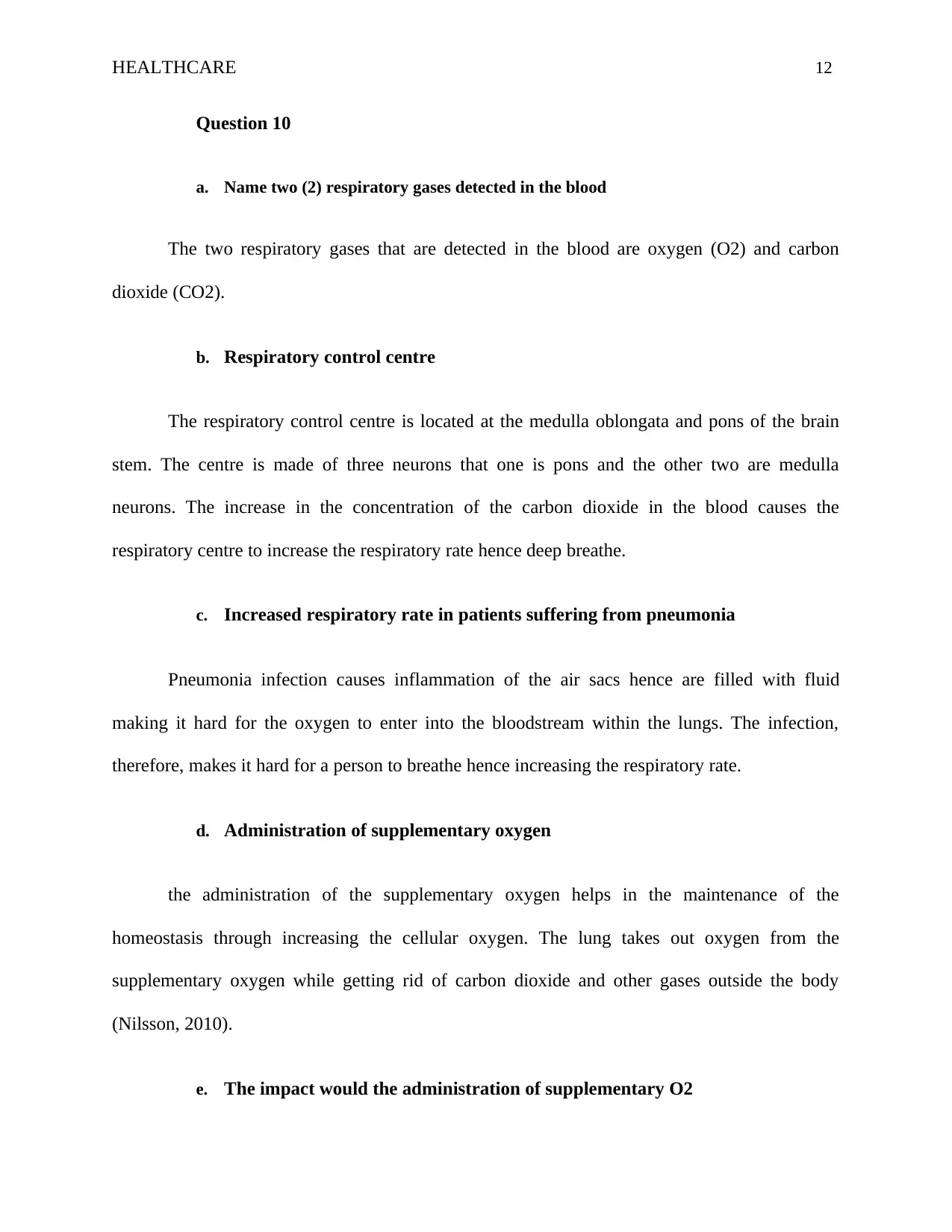
HEALTHCARE 12
Question 10
a. Name two (2) respiratory gases detected in the blood
The two respiratory gases that are detected in the blood are oxygen (O2) and carbon
dioxide (CO2).
b. Respiratory control centre
The respiratory control centre is located at the medulla oblongata and pons of the brain
stem. The centre is made of three neurons that one is pons and the other two are medulla
neurons. The increase in the concentration of the carbon dioxide in the blood causes the
respiratory centre to increase the respiratory rate hence deep breathe.
c. Increased respiratory rate in patients suffering from pneumonia
Pneumonia infection causes inflammation of the air sacs hence are filled with fluid
making it hard for the oxygen to enter into the bloodstream within the lungs. The infection,
therefore, makes it hard for a person to breathe hence increasing the respiratory rate.
d. Administration of supplementary oxygen
the administration of the supplementary oxygen helps in the maintenance of the
homeostasis through increasing the cellular oxygen. The lung takes out oxygen from the
supplementary oxygen while getting rid of carbon dioxide and other gases outside the body
(Nilsson, 2010).
e. The impact would the administration of supplementary O2
Question 10
a. Name two (2) respiratory gases detected in the blood
The two respiratory gases that are detected in the blood are oxygen (O2) and carbon
dioxide (CO2).
b. Respiratory control centre
The respiratory control centre is located at the medulla oblongata and pons of the brain
stem. The centre is made of three neurons that one is pons and the other two are medulla
neurons. The increase in the concentration of the carbon dioxide in the blood causes the
respiratory centre to increase the respiratory rate hence deep breathe.
c. Increased respiratory rate in patients suffering from pneumonia
Pneumonia infection causes inflammation of the air sacs hence are filled with fluid
making it hard for the oxygen to enter into the bloodstream within the lungs. The infection,
therefore, makes it hard for a person to breathe hence increasing the respiratory rate.
d. Administration of supplementary oxygen
the administration of the supplementary oxygen helps in the maintenance of the
homeostasis through increasing the cellular oxygen. The lung takes out oxygen from the
supplementary oxygen while getting rid of carbon dioxide and other gases outside the body
(Nilsson, 2010).
e. The impact would the administration of supplementary O2
⊘ This is a preview!⊘
Do you want full access?
Subscribe today to unlock all pages.

Trusted by 1+ million students worldwide
1 out of 20
Your All-in-One AI-Powered Toolkit for Academic Success.
+13062052269
info@desklib.com
Available 24*7 on WhatsApp / Email
![[object Object]](/_next/static/media/star-bottom.7253800d.svg)
Unlock your academic potential
Copyright © 2020–2025 A2Z Services. All Rights Reserved. Developed and managed by ZUCOL.

